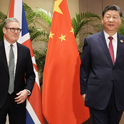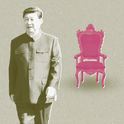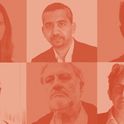As the third anniversary of the invasion approaches, Ukraine’s fate remains uncertain. The death toll mounts; war weariness and discontent are spreading in both Russia and Ukraine. Meanwhile, Russia’s church stands firmly by Vladimir Putin’s side, giving a pseudo-spiritual imprimatur to an unprovoked attack on a neighbouring country. Russia’s president has framed his “special military operation” as a divine mission. But why has Patriarch Kirill, the head of the Orthodox Church, so zealously backed it?
Kirill has lamented the war as “internecine strife” between Orthodox brothers, but when Russian generals faced a shortage of soldiers, he turned himself into a recruiting officer, promising eternal salvation to young men being sent to their deaths. Those who fall in battle to restore Holy Rus’ will go straight to heaven, he said. “This sacrifice washes away all the sins that a person has committed.”
Every major date in the Orthodox calendar is now used to defend the war. Soon after the invasion began in 2022, on Forgiveness Sunday, a day of goodwill marking the start of Lent, Kirill blamed gay pride parades in Europe for inciting the bloodshed. Last spring, the Church called Putin’s “special military operation” a Holy War to protect the world from a west that had succumbed to Satanism. This past Orthodox Christmas, on 6th January, in Moscow’s Cathedral of Christ the Saviour, the patriarch blessed icons and crosses engraved with the president’s initials to be sent to the most deserving fighters. He wished the Kremlin leader “God’s generous help in his responsible work for the good of Russia”, adding that western countries “hate us because we are offering a different, alternative path of civilised development”.
The patriarch’s hawkishness should surprise no one. As I argue in my 1,000-year history, the Church’s poisonous co-dependency with the state developed from the moment of its creation. Great Prince Vladimir renounced paganism in 988 not to please his grandmother Olga—one of the first converts—but to do business with Orthodox Constantinople and to better control his subjects, spread across newly conquered territories, under one ruler and one God.
By the 13th century, the relationship between church and state was entrenched. Under the Mongol Yoke, everyone had to pay tribute, from peasants to princes. Only the Church managed to get tax breaks by ingratiating itself with the descendants of Genghis Khan. This model still works today: Putin gives the Church considerable financial support.
Since the early 16th century, Russia’s church has been deeply divided over its attitude to wealth, torn between the stiazhateli, or possessors, and the nestiazhateli, non-possessors. The former, who prized rich, powerful churches and extensive land holdings, believed harmonious relations between church and ruler were essential. They have mostly had the upper hand for the past 1,000 years—and that is certainly the case today. In contrast, non-possessors, originally led by Nil Sorsky, a hermit monk, are more devoted to the spiritual realm. They argue that monasteries had too much property for their own good. The Church, Sorsky insisted, should be separate from the state and renounce worldly goods.
Along with their fixation on money, senior clerics promote Russian exceptionalism. Putin’s mindset owes much to Filofei of Pskov, a 16th-century abbot. Following the collapse of the Roman and Byzantine empires, Filofei declared Moscow the “Third Rome”. He told his monarch, Grand Prince Vasily III, that “all Christian realms are reduced to your realm alone”. The notion that Moscow has a sacred mission to redeem humanity has endured through the tumultuous reigns of empire-building tsars, to messianic Communists, to the present day.
Savagely repressed until the Second World War, the Church was revived when Stalin needed its support to beat the Germans. It was then tolerated so long as it did the regime’s bidding at home and abroad, overseen by the KGB. Across the centuries, whoever is in power, the Church has done whatever it takes to ensure its survival, its influence and its own enrichment.
The current patriarch was not always a sycophant. Like Putin, he is said to have had a KGB past, but some saw him as a reformer. He raised academic standards in seminaries, preached at rock concerts and reached out to other faiths. His reputation was, if anything, too pro-west. He described anti-government rallies in 2011 and 2012 as a “legitimate reaction to corruption” and ballot fraud. Putin’s security services, the FSB, soon stamped out any traces of liberalism in the head of the Church and brought him to heel. The media began running stories about his weakness for $30,000 Swiss watches and rows with his neighbours. At that point, in February 2012, Kirill declared Putin’s leadership was “a miracle from God”.
Within weeks of the invasion, Kirill gave an Orwellian sermon from the pulpit of the new Cathedral of the Russian Armed Forces, whose steps and floors are made from melted down German tanks. The patriarch declared that Russians are “very peace-loving and long-suffering people” who have no “aspirations for war”. That same day, pictures of corpses lying in the streets of Bucha were beamed around the world. Some 1,400 civilians from the Kyiv commuter town were killed by Russian troops.
The cathedral of the Armed Forces, with its khaki cladding, garish mosaics and ice blue windows, is emblematic of a neo-Soviet religion which mixes pride in the Red Army victory in the Second World War with superstition and a heavy dose of Russian nationalism. Church and state have created something which superficially resembles Orthodoxy but is more like a pagan cult fuelled by hatred, according to one priest who no longer serves under Kirill. “They have sacralised their Russkiy Mir (Russian World) and pray like the Pharisees: ‘Lord, we thank You that we are not like other nations.’ That’s the antithesis of Christianity,” said Father Andrey Kordochkin, who now serves in a Dutch parish under the Patriarch of Constantinople.
As Russia multiplies drone and missile attacks, the church ramps up its ever more outlandish rhetoric on social issues. One of the patriarch’s most bellicose clerics recently suggested that rocket strikes on Russia by Ukraine are God’s punishment for Russian women having abortions and asserted the war was caused by excessive masturbation. “If semen spills today, then blood spills tomorrow,” Archpriest Andrei Tkachev told his flock.
Kirill never tires of castigating a morally corrupt west, but his own clerics do not always set the best example. One of the most senior Russian bishops was recently accused of sexually harassing his young cell attendant. The Bishop initially wrote to the mother of his subordinate expressing “sincere regret for all the mistakes made”. Later on he denied the allegations of misconduct and accused the young man’s mother of trying to blackmail him. In an interview last October, he said he was the victim of “a defamation campaign” orchestrated by criminals and “experts who left Russia and specialise in tarnishing the Russian Church”. The bishop was recalled to Moscow from Hungary for a rap on the knuckles and then reassigned to a parish in the Czech resort town of Karlovy Var.
Some priests who refused to read Kirill’s victory prayer for Russian troops faced harsher punishments. Many have been defrocked. The priest who led a memorial service for the murdered opposition leader Alexei Navalny was banned from his job and ordered to serve three years of “penance”. Some antiwar priests have been forced to leave the country.
Kirill portrays his close relations with the Kremlin as a 21st-century version of the ancient Byzantine doctrine of symphonia, in which church and state work together for the good of the nation. Apart from the military and the FSB, no other organisation has enjoyed such prominence and protection in post-Soviet Russia. Kirill has earned that power by debasing his church and its liturgy. Once he became an active combatant in the war, he threw in his lot with Putin. They have stood together and will fall together.













